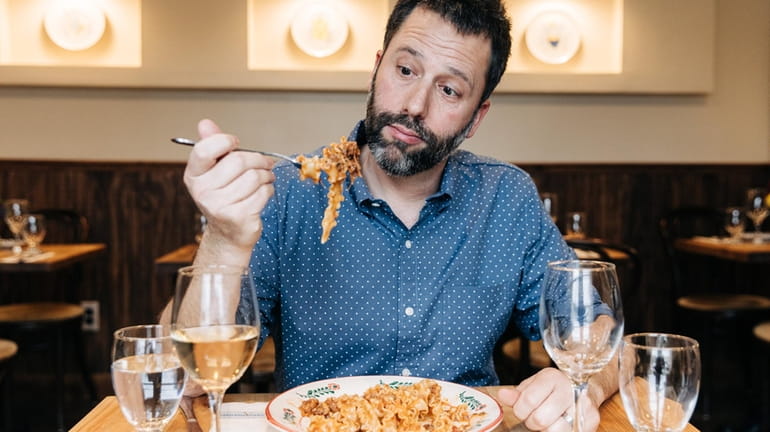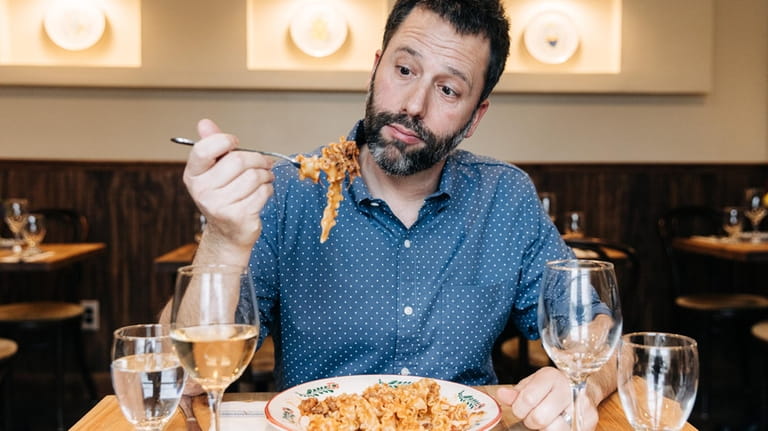Dan Pashman's 'Anything's Pastable' cookbook takes you inside the world of pasta

Dan Pashman dives into a dish at Trattoria Edorado in Huntington. Credit: Jeenah Moon
Dan Pashman thinks we should all be putting kimchi in our carbonara. But there’s one thing you won’t find in his inventive new cookbook, “Anything’s Pastable.” And that’s a recipe for scratch-made tomato sauce.
“If it’s your grandmother’s recipe and it’s meaningful to you or you just love making a sauce, then by all means, make tomato sauce from scratch,” the Long Island food writer and podcaster says. “But if that’s not you, I’m not quite sure why you would ever do it. There are so many good jarred sauces available now, it makes no sense to me. I would never make tomato sauce from scratch.”
Instead, you’ll find ingenious combinations such as keema Bolognese, which has you throwing Indian spices into hot melted butter until they bloom, before adding ground lamb and pappardelle noodles. And twists on Italian classics that have you grating tomatoes and spiking them with olives and Vietnamese fish sauce for a raw heirloom puttanesca.
An obsessive researcher with some contentious opinions, the host of The Sporkful podcast has never been afraid to reinvent the wheel … unless you’re talking about wagon wheels, the derided pasta style that he calls an “inherently flawed gimmick” that cooks unevenly. A New Jersey native who moved to Greenlawn in 2013, he’s just as quick to shout out a local pupusa spot (Don Juan Pupuseria in Huntington Station) as he is to recommend an authentic Italian joint (Edoardo’s Trattoria in Huntington).
On more than one occasion, he has publicly proclaimed that “spaghetti sucks.” And to prove that he can do better, he invented his own pasta shape. Developed with Hudson Valley pasta producer Sfoglini, Pashman designed cascatelli specifically to maximize his three pasta principles, “sauceability, forkability and toothsinkability.” (Spaghetti only has one of these, on a good day.)

Dan Pashman dives into a dish at Trattoria Edorado in Huntington. Credit: Jeenah Moon
Cascatelli, with its ruffled, curvy shape, looks a little bit like a fried pork rind and is uniquely positioned to grab each smidgen of sauce. It’s featured prominently in recipes such as the Chinese mapo tofu cascatelli and a trendy mashup, chili crisp — tahini pasta with fried shallots. (Pashman does provide substitutions for those who can’t snag a box of cascatelli at Whole Foods or select grocers.)
But even though he prefers the thicker spaghettoni to regular spaghetti, “Anything’s Pastable” does feature a regional Italian recipe for a fried dish called spaghetti all’assassina (assassin’s spaghetti) that he learned from one of its inventors during a research trip to Puglia. “I understand that some people are going to perceive me as kicking down the door of Italian food,” he said. “But we should recognize that Italian Americans have had a huge impact on changing food in Italy. There’s this idea that it all flows in one direction. That there’s a way that the nonnas in Italy made the food hundreds of years ago, and it came to America, and the goal of Italian Americans in America is simply to preserve these traditions that have been passed down. But that’s just not the reality.”

Dan Pashman's linginue with miso clam sauce. Credit: Dan Liberti
Pashman spent two years developing the recipes and testing the cookbook alongside a host of high-profile collaborators, who he chose for their expertise in international and regional American cuisine. The bubbly food personality James Park and culinary historian Irene Yoo experiment with Korean-fusion dishes such as tteokbokki rice cakes in a jarred tomato sauce. Chicago restaurateur Darnell Reed adds to the dialogue on Black soul food with dishes like Cajun crawfish carbonara. And Asha Loupy developed a host of Indian-inflected recipes, including the keema Bolognese.
This is the beauty of “Anything’s Pastable,” which was published in March. With their eclectic recipes, Pashman and his team give you permission to experiment with the whole world of wheat-based carbohydrates. Even when you’re not following the recipes word for word, the ideas and flavor combinations will stick in your head, especially the next time you succumb to the lure of littlenecks at the seafood market and think miso. For purists, this approach may seem like a slap in the face. But for others, that’s just a wonderful part of living in the metropolitan area.
“These are the kinds of things that happen naturally,” Pashman said. “People come from India, and they try pasta, and they end up putting a sauce that they know on top of it. And then someone like me ends up getting into cooking dal, and I have leftover pasta and I mix those together …. I just wanted to write a book that encapsulates how I do that, and how I want to do more of it, and how other people can do it, too.”
LINGUINE WITH MISO CLAM SAUCE
SERVES 4 TO 6
Total time: 1 hour 10 minutes (40 minutes active time)
developed by Dan Pashman with Irene Yoo
Linguine with clam sauce has a fantastic ratio of impressiveness to degree of difficulty. It feels like the kind of thing you’d only make on New Year’s Eve or for a dinner party for old friends, but in reality, with a bit of forethought, you can whip it up on a Tuesday night just because you deserve it. Miso adds umami savoriness to the brininess of this classic dish and makes it even more foolproof. The traditional pairing of this sauce with linguine has a lot of wisdom to it. Many people think linguine is just a narrower fettuccine, but if you look closely at its cross section, you’ll see it’s ovular, not flat. This makes it an ideal shape for slurping, because it’s easier for your lips to form a seal around it. Coating it in a thin, oily sauce like this one provides lubrication for slurping and maximizes linguine’s unique properties.
Ingredients
30 littleneck clams (21/2 to 3 pounds; see note)
4 tablespoons kosher salt
1/2 cup dry white wine
1/4 cup white or yellow miso
4 tablespoons (1/2 stick) unsalted butter
1 1/2 cups (7 1/2 ounces) cherry tomatoes, halved
4 garlic cloves, minced
1/2 teaspoon freshly ground black pepper
1 pound linguine (or spaghetti, fettuccine, or mafalde)
1/2 cup chopped fresh parsley
2 tablespoons freshly squeezed lemon juice
Crusty bread, for serving (optional)
Directions
1 | Place the clams in a large bowl and cover them with cold water. Stir the clams around a few times to loosen any sand and grit, then drain. Add fresh water to the bowl, covering the clams by at least 1 inch. Add 3 tablespoons of the salt, stir gently, and refrigerate for at least 30 minutes and up to 3 hours; drain.
2 | Bring 4 quarts of water and the remaining 1 tablespoon of salt to a boil in a large pot.
3 | In a small bowl or liquid measuring cup, whisk the wine and miso until no lumps remain; set aside.
4 | Melt the butter in a large, high-sided skillet over medium heat. Add the tomatoes and cook, stirring occasionally, until they are just starting to soften, 2 to 4 minutes. Add the garlic and cook, stirring, until fragrant, 1 to 2 minutes. Add the wine-miso mixture and the pepper, increase the heat to medium-high, and bring to a simmer. Add the drained clams, cover, and cook until most of the clams have opened up at least partially, 7 to 9 minutes. Uncover and cook, stirring occasionally, until all the clams are fully opened, 5 to 10 minutes. (If any clams remain closed at this point, remove and discard them. See the note for more details.) Remove the pan from the heat.
5 | Add the pasta to the boiling water and cook for 1 minute less than the low end of the package instructions. Use a slotted spoon or mesh spider to remove the clams from the sauce and transfer them to a bowl, then use tongs to transfer the pasta directly to the skillet. Return to medium heat and stir until the sauce just coats the pasta but is still very brothy, 1 to 3 minutes. Remove the pan from the heat and stir in 1/4 cup of the parsley and the lemon juice.
6 | Transfer the pasta to a serving platter or individual bowls, top with the clams and any accumulated juices, and sprinkle with the remaining 1/4 cup of parsley. Serve with crusty bread, if desired.
NOTE: When you buy clams, they should smell like seawater, not fishy, and the shells should be tightly closed. If any shells are open, tap them firmly; if they don’t close after that, discard those clams. If you aren’t cooking them immediately, store them in the fridge in netted bags or open-top containers, not in sealed bags. The soaking in step 1 helps clean the clams and get rid of grit. When you cook the clams, they should all open up at least 1/4 inch — any that don’t should be discarded. (If most of your clams aren’t opening, they may just need to cook a little longer, especially if they were on ice or very cold when you started.)

